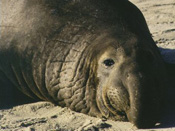Northern Elephant Seal (Mirounga angustirostris)
Status | Taxonomy | Species Description | Habitat | Distribution |Population Trends | Threats | Conservation Efforts | Regulatory Overview |
Key Documents | More Info
Status
MMPA - Northern elephant seals, like all marine mammals, are protected under the MMPA.
Taxonomy
Kingdom: Animalia
Phylum: Chordata
Class: Mammalia
Order: Carnivora
Family: Phocidae
Genus: Mirounga
Species: angustirostris
Species Description
Northern elephant seals are the largest phocid, or "true" seal, in the Northern Hemisphere. Fully grown males can reach lengths of over 13 ft (4 m) and can weigh nearly 4,400 lbs (2,000 kg). Females are significantly smaller than males, but are also quite large growing to about 10 ft (3 m) long and weighing up to 1,300 lbs (600 kg).
Pups are born in early winter from December to January. Breeding occurs from December to March, and gestation lasts around 11 months. Northern elephant seals are "polygamous"; males establish dominance over large groups of females during the breeding season.
Northern elephant seal pups are about 4 ft (1.2 m) long and weigh about 75 lbs (35 kg) at birth. Pups are generally black until they are weaned, when they are about 6 weeks old. They then molt and turn light silver. They gradually become darker brown or gray, though they often remain pale ventrally, or on their underside.
When males reach puberty at about 7 years old, they develop a large inflatable nose, or "proboscis." The proboscis overhangs their lower lip by about 8 in (20 cm). They also develop a robust, thick neck that is heavily creased and lighter in color--even slightly pink--compared with their dark bodies. Conversely, females maintain their smaller noses and smooth necks.
There is also a notable difference in life span between males and females. Females generally live for about 19 years, while males only live for about 13 years.
When at sea, Northern elephant seals feed mostly on squid and fishes, but they also eat rays and even sharks. When they return to land to breed or molt, they fast. During these fasting periods, they can lose up to half of their body mass!
Habitat
Northern elephant seals spend much of the year, generally about 9 months, in the ocean. They are usually underwater, diving to depths of about 1,000-2,500 ft (330-800 m) for 20-30 minute intervals with only short breaks at the surface. They are rarely seen out at sea for this reason. While on land, they prefer sandy beaches.
Distribution
Northern elephant seals are found in the eastern and central North Pacific Ocean. Though they range as far north as Alaska and as far south as Mexico, they typically breed in the Channel Islands of California or Baja California in Mexico.
Population Trends
Once thought to be extinct from commercial sealing in the 1800s, the population began to steadily increase in the early 1900s. Though a complete population count of elephant seals is not possible because all age classes are not ashore at the same time, the most recent estimate of the California breeding stock was approximately 124,000 individuals.
Threats
Entanglement in marine debris, fishery interactions, and boat collisions are their main threats.
Conservation Efforts
The IUCN Red List of Threatened Species ![]() considers this species "Least Concern."
considers this species "Least Concern."
Regulatory Overview
Northern Elephant Seals, like all marine mammals, are protected under the Marine Mammal Protection Act (MMPA) of 1972.
Key Documents
(All documents are in PDF format.)
| Title | Federal Register | Date |
|---|---|---|
| Stock Assessment Reports | n/a | various |
- NMFS National Marine Mammal Laboratory Northern Elephant Seal Information and Research
- NMFS Southwest Regional Office: CA Pinniped Rookeries & Haul-out Sites
- NOAA's National Marine Sanctuaries
- Southall, B. L. R. J. Schusterman, and D. Kastak. (2003). Acoustic communication ranges for northern elephant seals [pdf]. Aquatic Mammals 29, 202-213.
